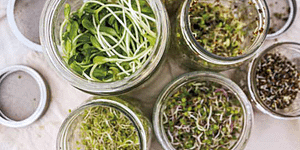Medicine as a Process, Not a Product

What do you picture when you think of medicine? Pharmacy shelves filled with plastic bottles promising cures to your every ailment? A doctor’s office? Whatever you think of, you probably don’t picture fields of medicinal herbs or bookshelves covered in jars of amber-colored liquid or trained hands drying leaves and cutting roots. What if, at its core, medicine is not about the product, but about the process.
The following is an excerpt from Following the Herbal Harvest by Ann Armbrecht. It has been adapted for the web.
(Organic calendula fields at Zack Woods Herb Farm, Vermont. Photo courtesy of Jeff and Melanie Carpenter.)
I first recognized medicine as a process rather than a product at a tincture-making workshop in the mid-1990s. The young teacher showed us a twisted echinacea root she had dug from her garden the previous day. “It’s easy to wash the roots,” she said. “Just use a strong hose.” She demonstrated how to break the root into smaller pieces to remove dirt from the crevices. “Cut up the root as small as possible,” she added as she chopped it into tiny pieces. She explained that the greater the surface area that comes into contact with the menstruum— the solvent used to extract compounds or constituents from the plant material—the more constituents would be extracted. She dumped the root bits into a mason jar, covered the roots with vodka, put a lid on the jar, and shook. Let it sit in a dark place for six weeks, she said, then strain off the liquid, which is the medicine. The leftover bits of root, called the marc, can be composted.

Chopping freshly harvested valerian root before washing and processing at Oregon’s Wild Harvest, Sandy, Oregon.
The demonstration lasted only ten minutes. For the remainder of the hour-long class, the instructor talked about the uses of various medicinal plants. I only half listened. I was still marveling at the simplicity of the medicine making. It would be one thing if making a tincture was difficult or time consuming, but it isn’t. The process is a bit messy, but it is easier than making a cake, even a cake from a packaged mix. And yet I had never before considered the possibility that I could make my own medicine. To me, medicine was what I bought at a pharmacy, what a doctor would prescribe for me, not something concocted with roots and leaves and some vodka in my kitchen. Why hadn’t anyone ever told me how easy this was? Or that I could do it myself? In my own home? With the root of a plant I could grow in my own garden? And that it was so inexpensive? I was preoccupied by the cost and by another more confounding question, which I had never considered before. When— and how—had medicine become a product to buy instead of a skill we could share?
Restoring Balance
The following year I met Deb Soule at a retreat to envision an organization that would honor of the work of simple-living advocates Helen and Scott Nearing. Deb ran a small apothecary selling remedies prepared from herbs grown in her biodynamic gardens in Downeast Maine. She brewed pots of tea from loose dried flowers and leaves. I was used to my coffee strong and my tea in bags, and so I was curious. It tasted a bit like grass. Deb talked about her gardens and the medicines she made in her kitchen and the community clinic where she met with clients. It all sounded small-scale and right-sized. She mentioned that she was buying some land up the road from her house to expand her gardens and that I should come visit.

When I was growing up, I never would have found medicinal oil in the oven in our family’s kitchen. More likely it would have been Hamburger Helper or minute steaks on the stovetop. The salads of my childhood were a chunk of iceberg lettuce with a dollop of bright orange French dressing from a bottle. Nestlé’s chocolate chip cookies were as homemade as we got. This wasn’t because my mother was negligent or didn’t care. This was the 1960s in West Virginia. The promise of the modern era was for women to spend less, not more, time in the kitchen, and I was born into a social class where that shift was possible. What mattered about food was that it was convenient and quick, not where the ingredients came from or how they had been processed. I grew up thinking of my body as something to exercise and to fuel as needed, like a car. I depended on my body, but didn’t think much about how it worked. When I was a college student at Dartmouth, a tree or a plant was what I passed as I hiked—or better yet, ran—up the trail to reach the top of the mountain.
Deb went on walks, not runs. She drank teas that nourished her body, not ones that kept her awake. She ate the foods she could grow in her garden, and whole grains she could grind herself.
Being with Deb, I was reminded of what I’d experienced in Nepal— in the way she talked, in the little things she noticed, in the pace at which she worked. She didn’t let the hurry around her change her rhythm. Her hands, like the hands of the women in Hedangna, were rough from a lifetime of working the soil. And she talked about plants as if they were alive—as if they were people with whom she could have a relationship, with whom she did have a relationship.
Recommended Reads
Recent Articles
Want to start your own medicinal herb garden? Passionflower, lemon balm, and goldenseal are great places to begin! These herbs are jam-packed with medicinal properties and easy to grow in a majority of climates.
Read MoreSprouts are easy to cultivate, mature quickly and pack a nutritional punch! You can make nutrient-rich sprouts from all kinds of edible seeds in your kitchen.
Read MoreSuffering from frequent headaches is miserable and immobilizing. If you haven’t had luck treating and preventing your headaches, skip the over-the-counter approach and prepare herbal formuals for migraines to use in the future! The following is an excerpt from Herbal Formularies for Health Professionals, Volume 4 by Jill Stansbury. It has been adapted for the…
Read More“It is more important to know what kind of person has a disease than to know what kind of disease a person has.” —Hippocrates Drawing on her decades of clinical experience and her extensive research, Dr. Jill Stansbury offers an unparalleled range of herbal formulas in her five-volume set, Herbal Formularies for Health Professionals. For each…
Read MoreUsing herbal medicine to heal the body is an ancient practice. It has since become a worldwide industry. Today, modern-day doctor’s visits and industrial medicine have displaced common knowledge of herbal medicine. Some still remember the ancient practice. In her book Following the Herbal Harvest, Ann Armbrecht interviews one such person, Phyllis Light, a fourth-generation…
Read More








